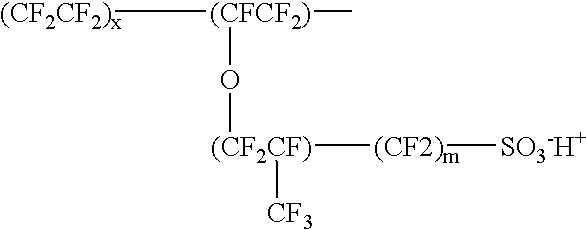Proton-selective conducting membranes
a conducting membrane and selective technology, applied in the field of protonselective conducting membranes, can solve the problems of environmental and safety risks, leakage, and requirement of additional cell elements
- Summary
- Abstract
- Description
- Claims
- Application Information
AI Technical Summary
Benefits of technology
Problems solved by technology
Method used
Image
Examples
example 1
[0255] Double layer capacitor energy storage components were constructed. The cell includes two electrodes separated by a proton conducting polymer membrane, each electrode having a thickness of about 0.3 mm, and terminal current collectors. The electrodes include a high surface area carbon powder and an aqueous solution of sulfuric acid. The terminal current collectors include a conductive carbon composite film of about 50 microns thickness. The membrane includes 62 w / o PSu and 38 w / o PVP and its thickness is about 40 microns. The internal resistance of such cells, as built, is about 2 ohms. The measured nominal capacity of the cells is 160 micro-amp hours.
example 2
[0256] Double layer capacitors were built as in Example 1. The membrane contains 57 w / o PSu and 43 w / o PVP and its thickness is about 50 microns. The internal resistance of such cells as built is about 1.5 ohms.
example 3
[0257] Rechargeable battery cells were constructed. The cell includes two electrodes of about 0.2 mm thickness each that are separated by a proton conducting polymer membrane, and terminal current collectors. The cathode electrode includes a carbon powder and an active material of manganese sulfate. The anode contains a carbon powder and a tin compound. The terminal current collectors include a conductive carbon composite film of about 50 microns thickness. Cells were built with the membrane compositions as described in the table below and were cycled at 4 mA constant current for the charge and for the discharge half-cycles. Discharge capacities were measured to a cut-off voltage of 1.15 volts. The nominal closed circuit voltage was 1.5 volts at this drain. The cross-sectional area of the electrodes was 1 square centimeter. (The cell series code is C578-NM-1-99-92.) Cells were cycled for about 50 cycles to demonstrate cyclability. The percent composition of the membrane in the table...
PUM
| Property | Measurement | Unit |
|---|---|---|
| thickness | aaaaa | aaaaa |
| thickness | aaaaa | aaaaa |
| thickness | aaaaa | aaaaa |
Abstract
Description
Claims
Application Information
 Login to View More
Login to View More - R&D
- Intellectual Property
- Life Sciences
- Materials
- Tech Scout
- Unparalleled Data Quality
- Higher Quality Content
- 60% Fewer Hallucinations
Browse by: Latest US Patents, China's latest patents, Technical Efficacy Thesaurus, Application Domain, Technology Topic, Popular Technical Reports.
© 2025 PatSnap. All rights reserved.Legal|Privacy policy|Modern Slavery Act Transparency Statement|Sitemap|About US| Contact US: help@patsnap.com



